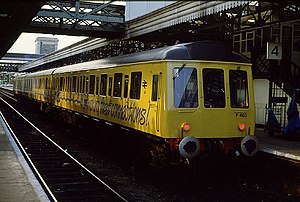This article needs additional citations for verification. (June 2020) |
The British Rail Class 118 diesel multiple units were built by the Birmingham Railway Carriage and Wagon Company (BRCW) and introduced from 1960. It was a licence-built version of the British Rail Class 116.[1]
| British Rail Class 118 | |
|---|---|
 BR class 118 DMU Nos. 51302+59469+51317 in British Telecom advertising livery | |
| In service | 1960-1994 |
| Manufacturer | Birmingham Railway Carriage and Wagon Company |
| Number built | 15 sets (45 cars) |
| Number preserved | 1 car (DMS 51321) |
| Formation | 3-car sets: DMBS-TCL-DMS |
| Capacity | DMBS: 65 second TCL: 24 first, 50 second DMS: 89 second |
| Operators | British Rail |
| Lines served | Western Region |
| Specifications | |
| Car length | 64 ft 6 in (19.66 m) |
| Width | 9 ft 3 in (2.82 m) |
| Maximum speed | 70 mph (113 km/h) |
| Weight | Power cars: 36 long tons 0 cwt (80,600 lb or 36.6 t), Trailer cars: 30 long tons 0 cwt (67,200 lb or 30.5 t) |
| Prime mover(s) | Two BUT engines per power car |
| Power output | 150 hp (112 kW) per engine |
| Safety system(s) | AWS |
| Multiple working | ■ Blue Square |
History
editBR Derby was inundated with orders for the Class 116, so the work was put out to tender. All Class 118s were built in Birmingham by Birmingham Railway Carriage and Wagon Company.[2]
Originally allocated to the Western Region, the 118 was extensively used in Devon and Cornwall. They were stabled at Laira depot. The 118s survived in service in the region until 1994 when they were replaced by Class 156s.[citation needed]
In its final days, vehicles were allocated to Tyseley depot in Birmingham, and were all withdrawn by the end of 1994. Like most first generation DMUs they were originally BR Green, then plain blue, and finally blue and grey, with a few receiving Network SouthEast livery. One set was painted in all over yellow with advertisements for British Telecom.[3]
A normal formation was three vehicles- a Driving Motor Brake Second (DMBS) which had two BUT engines (Later fitted with Leyland), a driving compartment (cab), 65 second class seats, guards accommodation and luggage/parcels space, a Trailer Composite Lavatory (TCL) which had no engines or driving compartment, but had 22 first class seats, 48 second class seats and a lavatory, and a Driving Motor Second (DMS), which like the DMBS had two engines and a driver's cab, and contained 89 second class seats. Having the 'blue square' multiple working system allowed them to run in formations containing up to 12 cars with most of BR's other DMUs.
Orders
edit| Lot No. | Type | Diagram | Qty | Fleet Numbers | Notes |
|---|---|---|---|---|---|
| 30543 | Driving Motor Brake Second (DMBS) | 850 | 15 | 51302–51316 | |
| 30544 | Trailer Composite with lavatory (TCL) | 851 | 15 | 59469–59483 | |
| 30545 | Driving Motor Second (DMS) | 852 | 15 | 51317–51331 |
Preservation
editOnly one Class 118 vehicle, DMS Number 51321, has been preserved and is at the Battlefield Line. This vehicle has been paired with class 116 DMBS 51131, also based on the railway.
References
edit- ^ "Preserved Vehicles".
- ^ "Class 118 DMU".
- ^ "Class 118 DMU Operations". www.railcar.co.uk.
- ^ "Railfaneurope.net". Archived from the original on 25 January 2013. Retrieved 29 May 2020.
- Motive Power Recognition: 3 DMUs. Colin J. Marsden
- British Railway Pictorial: First Generation DMUs. Kevin Robertson
- British Rail Fleet Survey 8: Diesel Multiple Units- The First Generation. Brian Haresnape
- A Pictorial Record of British Railways Diesel Multiple Units. Brian Golding